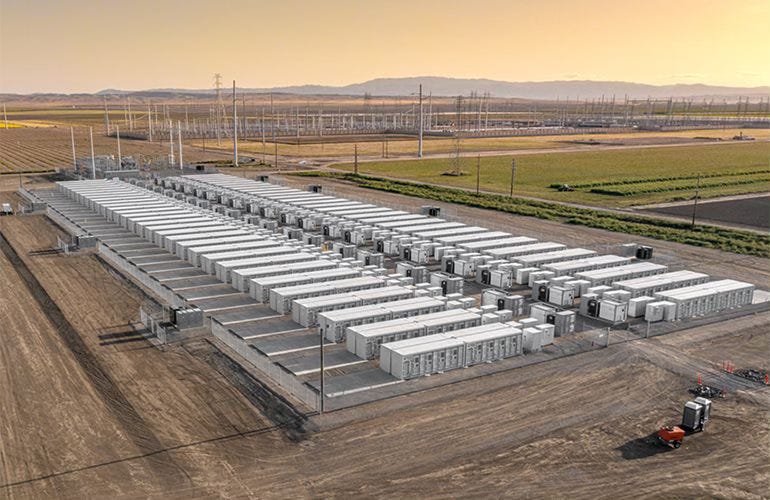The Battery Dilemma
Energy Transition, Mineral Conflict, and U.S. Foreign Policy
In the last few months, I’ve been conducting research on policy recommendations for reshoring at least some of the critical mineral processing industry to the United States and key allies. Minerals are one of the unseen parts of the supply chains that power a lot of the technology that we interact with daily, basically anything with a battery.
With an energy industry increasingly reliant on renewable energy, the policy debate over critical minerals has turned into a central fault line in international relations. Renewable energy generators, such as wind turbines and solar panels. require extensive use of minerals. But, due to the intermitant nature of these energy sources, they require huge battery arrays to store excess energy and to supply energy when little power is being generated.
What used to be the domain of geologists and mining executives is now shaping defense, trade, and modern conflict. Welcome to the battery-fueled era of geopolitics.
At the core of this shift is the explosion in global demand for batteries, especially lithium-ion units, which power everything from smartphones and EVs to massive data centers. In Q4 2024 alone, the U.S. installed nearly 13 GW of utility-scale solar capacity, a 142% surge from the previous quarter, and developers now have over 18.7 GW of battery storage capacity under construction. This isn’t a one-off spike. The U.S. grid of the future will be heavily reliant on scalable storage, and the materials needed to make that happen, such as lithium, cobalt, nickel, graphite, are in limited supply and problematic hands.
According to S&P Global, U.S. lithium-ion battery imports (mostly from China) hit record highs at the end of last year. Meanwhile, China dominates global production of 30 of the 44 U.S.-designated critical minerals, per the U.S. Geological Survey. Domestic production potential exists—but time is short, and the gap is currently being filled by adversaries and unstable suppliers.
The Return of Resource Wars
This brings us to the darker side of the green transition: the global mineral race is already fueling conflict, corruption, and coercion. Nowhere is this clearer than in the Democratic Republic of the Congo (DRC), where cobalt extraction has long been tied to child labor, environmental devastation, and armed conflict.
At the same time, the war in Ukraine has sharpened awareness of resource-security. Russia’s invasion prompted an urgent reevaluation of supply dependencies, not only for oil and gas but also for metals like lithium, of which Ukraine has four of Europe’s largest deposits. Sanctions and warfare have squeezed availability and forced countries to secure alternative sources, many of which are themselves fragile or geopolitically complex.
These aren’t isolated crises. They’re symptoms of a broader truth: as energy systems evolve, the bottlenecks are no longer in the oil fields of the Persian Gulf but in the mines of Africa, South America, and Southeast Asia. The U.S. and its allies are in a race not just for supply, but for control.
The Trade War We’re Already In
This mineral scramble is bleeding into trade policy. The U.S. and China are no longer in a slow-motion decoupling; they're in a full-scale trade standoff, intensified by the technologies of the energy transition. Chinese firms, backed by aggressive state financing and industrial strategy, dominate refining capacity for nearly every major battery input.
American tariffs on Chinese solar and battery imports, originally introduced under President Trump and expanded by Biden, aim to reverse that trend. But retaliation is growing sharper, more targeted, and more sophisticated. In the current nascent trade war, China has completely cutoff critical mineral supplies to the United States.
As noted by the Council on Foreign Relations, the International Energy Agency’s (IEA) clean energy ambitions are colliding with reality. Energy demand rose by 2.2% last year: up from an 1.8% increase in 2023. The emissions bump was modest at 0.8%, but it underscored a troubling cycle: rising temperatures drive more energy use, which requires more clean energy infrastructure, which in turn demands more mining and refining.
Balancing Interests and Values
So how should the U.S. navigate this thicket of interests? There’s no easy answer. On one hand, reducing dependence on adversaries like China is a strategic imperative. On the other, simply shifting supply chains from Beijing to the DRC without addressing the unstable or exploitative production environment presents a moral hazard.
Policymakers face a triple bind: they must accelerate domestic extraction and refining (a notoriously slow and environmentally fraught process), strengthen alliances with mineral producers (like Australia and Canada), and enforce standards for sourcing in fragile states. Some progress is being made (including initiatives to trace mineral origin and improve labor standards), but enforcement remains thin and market pressure to cut costs often wins out.
The Age of Clean Power Politics
If 20th-century geopolitics was built around oil, the 21st will be shaped by minerals and batteries. This is not just what powers your car, but what also powers the electric grid and emerging technology like artificial intelligence. With U.S. data centers expected to consume nearly 800 TWh of power by 2030, there is a need for energy at larger and larger scales.
America needs to move fast—but not blindly. The goal must be not just “secure supply,” but “just supply.” Industrial policy must align with strategic interests and humanitarian concerns. Targeted trade war tactics like tariffs are sometimes necessary, but they should be paired with investments in allies, regulatory reform, and transparency. The energy transition is not just an engineering challenge, but a global one.



